TO CLAIM A FIND FOR THIS EARTH CACHE, YOU NEED TO ANSWER THE FOLLOWING QUESTIONS:
-
From your observations at GZ, what type of unconformity do you observe between the dark Malmesbury shale and overlying lighter coloured Table Mountain sandstone? Explain your answer.
-
Walk around the flat rock prominence indicated by GZ. Describe at least two features your see demonstrating any of Steno’s Principles of Stratigraphy. Indicate in your answer which strata you consider being older.
-
Based on your new-found knowledge of Steno’s Principles, study the image below and then list the provided events in sequence from oldest to youngest:

PLEASE NOTE: Event B refers to the first horizontal erosion and subsequent unconformity indicated by Line A anot NOT the vertical valley erosion through layers 1 & 6.
This Earth Cache will take you to a rock shelf along the Hermanus coast. This site is not only a contact zone between two different sedimentary layers, but also a perfect vantage point from where to observe two very important geological concepts:
-
Steno's Principals of Stratigraphy, and
-
Geological unconformities.
Geological Time - An Overview
Time is relative; what a mayfly may call an eternity is a mere day to humans and less than a blink of the eye in terms of creation. The Earth is old, very old - recent studies have dated our mother planet around 4.6 billion years. But the question remains, what is geologically old versus young, and how do geologists determine this?
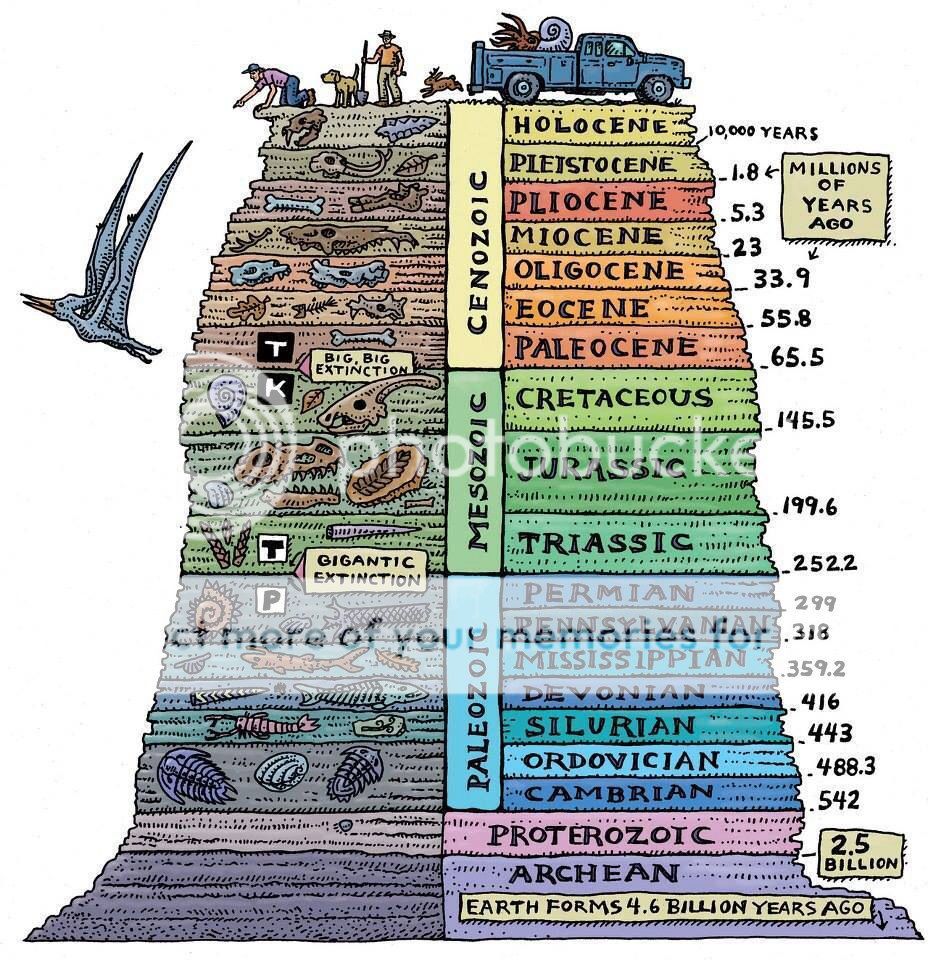 As in any science, the answer can be relative or absolute, depending on your dating technique. In relative dating, the goal is to unravel a sequence of geological events that may include the formation of a rock body, or its alteration (removal by erosion; deformation by faulting, folding, or intrusion of magma; and/or metamorphism by heat and pressure), but the actual age of the event remains unknown. In absolute dating, the objective is to actually date the timing of the event which helps make interpretation of the sequence of events it is related to more accurate. Determining the relative age of a geological event requires the determination of its proper place or position within a chronological sequence that includes all of the events found at a given locality, even though the actual ages of events are unknown.
As in any science, the answer can be relative or absolute, depending on your dating technique. In relative dating, the goal is to unravel a sequence of geological events that may include the formation of a rock body, or its alteration (removal by erosion; deformation by faulting, folding, or intrusion of magma; and/or metamorphism by heat and pressure), but the actual age of the event remains unknown. In absolute dating, the objective is to actually date the timing of the event which helps make interpretation of the sequence of events it is related to more accurate. Determining the relative age of a geological event requires the determination of its proper place or position within a chronological sequence that includes all of the events found at a given locality, even though the actual ages of events are unknown.
The order of events and the relative passage of time can be deduced from several universal Stratigraphic Principles related to rock bodies and geological structures.
Stratigraphic Principles:
In 1669, Danish scientist Niels Stensen (1638-1686), better known by his Latinized name Nicolaus Steno, formulated a set of principles based on his observations of sedimentary rocks. Several of these propositions, as later refined by English geologist, William Smith (1793-1839), have since become fundamental to geologists studying all kinds of rocks.
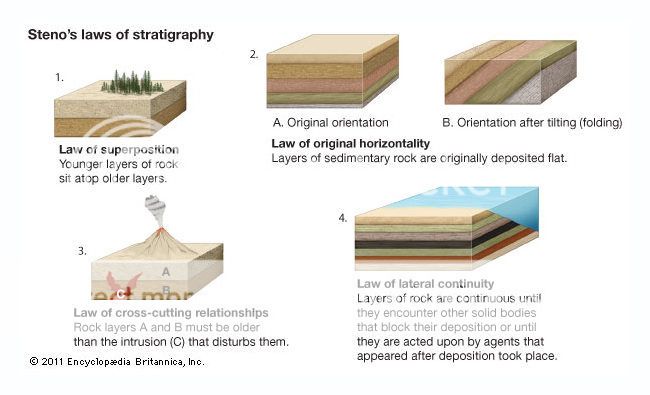
Steno's Principle of Superposition
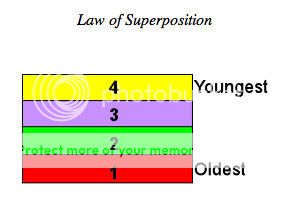 "At the time when any given stratum was being formed, all the matter resting upon it was fluid, and, therefore, at the time when the lower stratum was being formed, none of the upper strata existed."
"At the time when any given stratum was being formed, all the matter resting upon it was fluid, and, therefore, at the time when the lower stratum was being formed, none of the upper strata existed."
Basically, he deduced that rocks were laid down in vertical order just as sediments are laid down in water.
Conclusion: In a sequence of undeformed sedimentary and/or volcanic rocks, the oldest rocks are at the base, becoming progressively younger toward the top.
Steno's Principle of Original Horizontality
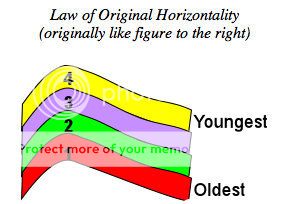 ". . . strata either perpendicular to the horizon or inclined to it, were at one time parallel to the horizon."
". . . strata either perpendicular to the horizon or inclined to it, were at one time parallel to the horizon."
Steno reasoned that strongly tilted rocks did not start that way, but were affected by later events.
Conclusion: Sedimentary rocks (and more broadly, volcanic lava flows and pyroclastic deposits) are initially deposited in subhorizontal layers conforming to the topography they are laid down upon. Therefore tilted strata indicates deformation and the passage of time necessary to complete that deformation via many different processes ranging from tectonics to intrusions.
Steno's Principle of Lateral Continuity
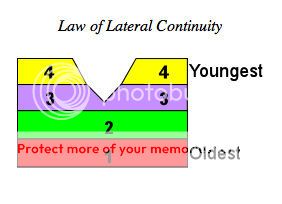 "Materials forming any stratum were continuous over the surface of the Earth unless some other solid bodies stood in the way."
"Materials forming any stratum were continuous over the surface of the Earth unless some other solid bodies stood in the way."
This principle allowed Steno to link identical rocks on opposite sides of a river valley and deduce the history of events that separated them.
Conclusion: A layer of sedimentary and/or volcanic rock is initially deposited as a broad, continuous sheet, its pattern disrupted only by obstructions (land forms) that occur at higher positions and/or by subsequent erosion.
The Principle of Cross-cutting Relationships
 "If a body or discontinuity cuts across a stratum, it must have formed after that stratum."
"If a body or discontinuity cuts across a stratum, it must have formed after that stratum."
With this principal, Steno explained the presence of intrusions.
Conclusion: A rock body must exist before it can be altered, therefore strata altered by another intruding rock body or disrupting geological structure must be older than that altering event. Such altering events can include folding, faulting and the emplacement of dykes and sills.
Geological unconformity:
Sedimentary (and often volcanic) rocks are initially deposited in subhorizontal layers. When an interruption in the process of deposition occurs, geologists can infer that some amount of time is missing from the rock record, presumably induced by some geological event or events that affected the area where the rocks where forming. This event or events could involve simple nondeposition, or involve much more extensive alteration related to intrusion, uplift and deformation, and removal by erosion. The break in the sequence, and its implied gap in time, is referred to as an unconformity. The time passage and degree of alteration indicated by the interruption in the deposition of sediment can be interpreted from a characterization of the type of unconformity:

Disconformity – Layers of subhorizontal sedimentary or volcanic rock separated by a nondeposition or erosion surface implies the shortest time gap and the least alteration.
Angular Unconformity – Younger sedimentary or volcanic layers deposited horizontally over older strata that was initially deposited horizontally, then tilted by deformation and beveled by erosion implies an intermediate amount of time and alteration.
Nonconformity – Younger rock layers deposited horizontally over the eroded surface of older intrusive igneous and/or metamorphic “crystalline” basement rock implies the greatest time gap and the most significant alternation.
References and photos:
- http://intheplaygroundofgiants.com/geology-basics-2/an-introduction-to-physical-geology/
- http://geology.about.com/od/geoprocesses/tp/steno-principles.htm
- Wikipedia
- Geological Journeys - Nick Norman & Gavin Whitfield
Remember to accompany your log with an email as lonesome logs will be deleted.

Suikerbossies are a South African geocaching team.
You can follow our adventures on our Facebook Page Suikerbossies Geocaching Adventures.
Suikerbossies have earned GSA's highest level:

